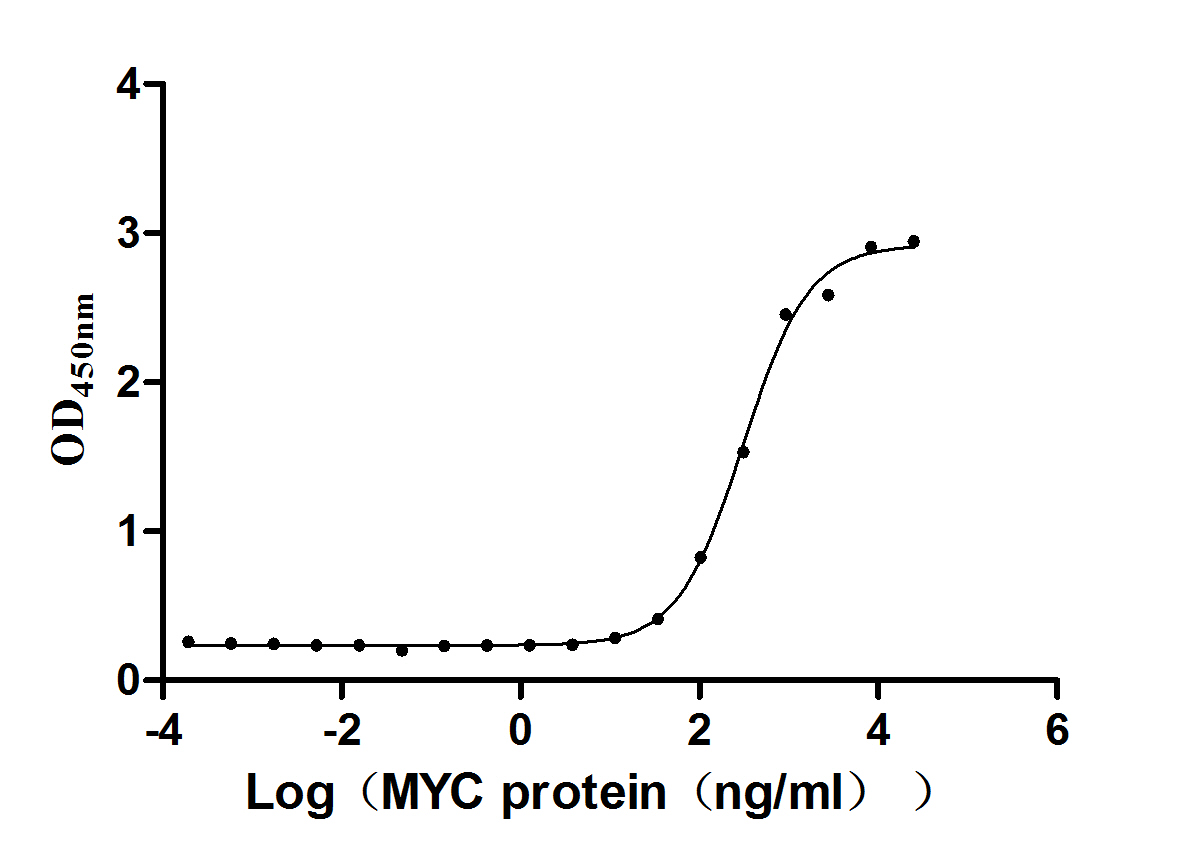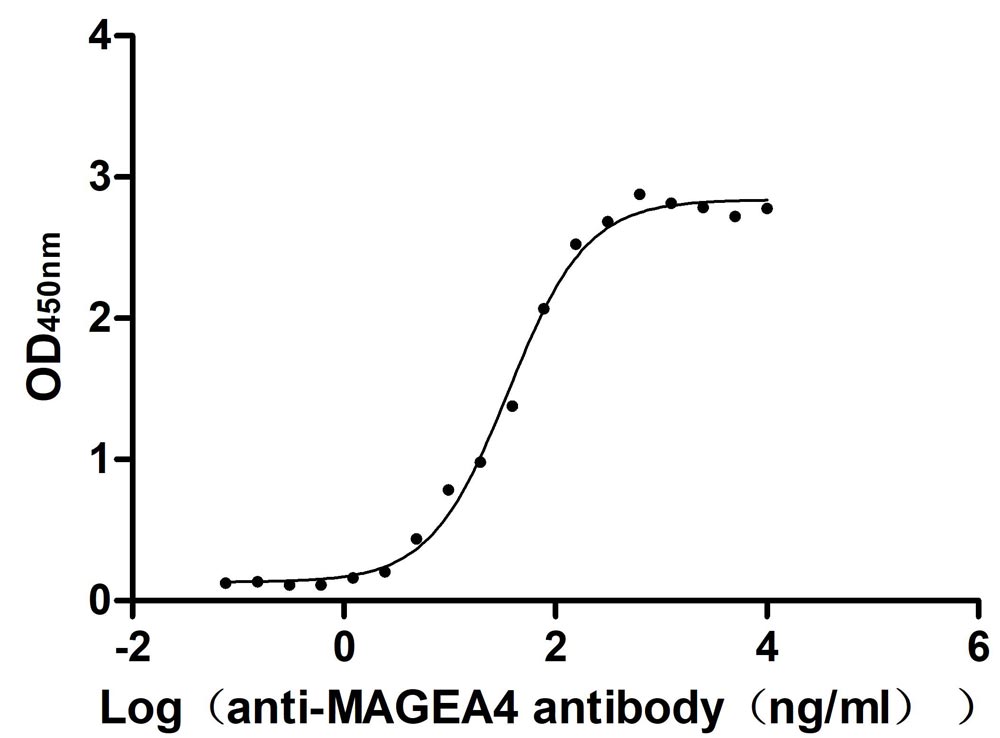Recombinant Mouse Myelin proteolipid protein (Plp1), partial
-
货号:CSB-YP018202MO1
-
规格:
-
来源:Yeast
-
其他:
-
货号:CSB-EP018202MO1
-
规格:
-
来源:E.coli
-
其他:
-
货号:CSB-EP018202MO1-B
-
规格:
-
来源:E.coli
-
共轭:Avi-tag Biotinylated
E. coli biotin ligase (BirA) is highly specific in covalently attaching biotin to the 15 amino acid AviTag peptide. This recombinant protein was biotinylated in vivo by AviTag-BirA technology, which method is BriA catalyzes amide linkage between the biotin and the specific lysine of the AviTag.
-
其他:
-
货号:CSB-BP018202MO1
-
规格:
-
来源:Baculovirus
-
其他:
-
货号:CSB-MP018202MO1
-
规格:
-
来源:Mammalian cell
-
其他:
产品详情
-
纯度:>85% (SDS-PAGE)
-
基因名:Plp1
-
Uniprot No.:
-
别名:Plp1; Plp; Myelin proteolipid protein; PLP; Lipophilin
-
种属:Mus musculus (Mouse)
-
蛋白长度:Partial
-
蛋白标签:Tag type will be determined during the manufacturing process.
The tag type will be determined during production process. If you have specified tag type, please tell us and we will develop the specified tag preferentially. -
产品提供形式:Lyophilized powder
Note: We will preferentially ship the format that we have in stock, however, if you have any special requirement for the format, please remark your requirement when placing the order, we will prepare according to your demand. -
复溶:We recommend that this vial be briefly centrifuged prior to opening to bring the contents to the bottom. Please reconstitute protein in deionized sterile water to a concentration of 0.1-1.0 mg/mL.We recommend to add 5-50% of glycerol (final concentration) and aliquot for long-term storage at -20℃/-80℃. Our default final concentration of glycerol is 50%. Customers could use it as reference.
-
储存条件:Store at -20°C/-80°C upon receipt, aliquoting is necessary for mutiple use. Avoid repeated freeze-thaw cycles.
-
保质期:The shelf life is related to many factors, storage state, buffer ingredients, storage temperature and the stability of the protein itself.
Generally, the shelf life of liquid form is 6 months at -20°C/-80°C. The shelf life of lyophilized form is 12 months at -20°C/-80°C. -
货期:Delivery time may differ from different purchasing way or location, please kindly consult your local distributors for specific delivery time.Note: All of our proteins are default shipped with normal blue ice packs, if you request to ship with dry ice, please communicate with us in advance and extra fees will be charged.
-
注意事项:Repeated freezing and thawing is not recommended. Store working aliquots at 4°C for up to one week.
-
Datasheet :Please contact us to get it.
相关产品
靶点详情
-
功能:This is the major myelin protein from the central nervous system. It plays an important role in the formation or maintenance of the multilamellar structure of myelin.
-
基因功能参考文献:
- These results suggest that colitis promotes rapid enteric neurogenesis in adult mice and humans through differentiation of Sox2- and PLP1-expressing cells, which represent enteric glia and/or neural progenitors PMID: 28566702
- This study demonstrated that Genetic dissection of oligodendroglial and neuronal Plp1 function in a novel mouse model of spastic paraplegia type 2. PMID: 28836307
- The rumpshaker missense mutation in the Plp1 gene gives rise to subcortical myoclonus PMID: 28382685
- axonal mitochondria, smooth endoplasmic reticulum, and microtubules were characterized in rodent optic nerves where PLP is replaced by the peripheral nerve myelin protein, P0. PMID: 27872255
- The observations collectively support the idea that GST-pi(Nuc)/DM-20 mRNA-expressing cells are the progeny of NG2-positive OPCs rather than a novel type of oligodendrocyte-lineage progenitor cells and that DM-20 mRNA expression is dynamically regulated during differentiation of OPCs into oligodendrocytes. PMID: 26921198
- Both extracellular and intracellular epitopes of PLP contribute to the pathogenesis of MP4-induced experimental autoimmune encephalomyelitis already in the setting of intact myelin. PMID: 25959684
- The insertion of native PLP into Olg mitochondria of animals with PLP1/Plp1 regulates extracellular pH and adenosine triphosphate. PMID: 24382809
- This study shows for the first time that Plp-null mice exhibit severe early-onset thermal hyperalgesia that is not associated with changes in thermal allodynic behavior. PMID: 24423646
- A novel mechanism sheds light on the immune regulation by which sulfatide-reactive type II natural killer (NK)T cells suppress inflammatory class II histocompatibility-restricted pathogenic CD4+ T cell responses in a T cell-mediated autoimmune disease. PMID: 24973441
- that an early reactive glia response occurs following mutations in the PLP gene PMID: 24314267
- Result suggest that plp1 plays a role either in the structural integrity of oligodendrocyte progenitor cell processes or in their response to extracellular cues that orient process outgrowth. PMID: 24453324
- PLP contributes to the high cholesterol content of myelin by association and co-transport in the central nervous system. PMID: 23322581
- Olig2/Plp-positive progenitor cells give rise to Bergmann glia in the cerebellum. PMID: 23492777
- PLP1 mutants inhibit Golgi apparatus to endoplasmic reticulum trafficking and have a role in pathogenesis of Pelizaeus-Merzbacher disease PMID: 23344956
- The results presented here suggest that the antisilencer/enhancer is largely dispensable for the developmental regulation of Plp1 gene expression in vivo. PMID: 23157328
- Our data indicate that miR-20a, a component of the cluster that controls oligodendrocyte cell number, regulates myelin proteolipid protein gene expression PMID: 22504928
- PLP gene expression is evident in both neuronal and oligodendroglial phenotypes in developing neostriatum. PMID: 21912090
- The developmental increase in Plp1 gene expression that occurs during the active myelination period is governed by transcription regulatory elements present within the first intron. PMID: 21472765
- Plp promoter activity is not restricted to the myelinating cell lineage, but rather, has widespread activity both during embryonic and early postnatal development. PMID: 21572962
- We conclude that PLP reaches the cell surface via at least two trafficking pathways with distinct regulations PMID: 21490207
- Central nervous system myelination is compromised by overexpression of proteolipid protein PLP/DM20 in a transgenic mouse model of Pelizaeus-Merzbacher disease. PMID: 20629189
- restoring wild-type PLP/DM20 levels in rumpshaker improves the phenotype and the integrity of myelin, but hypomyelination persists and stress pathways remain activated; both gain- and loss-of-function mechanisms may be involved in the pathogenesis PMID: 20175203
- the data of this study proved that PLP promoter-expressing OPCs continue to generate glutamatergic pyramidal neurons in the adult piriform cortex. PMID: 20826667
- Plp expression in medulla neurons was restricted to neurons with specific ligand-gated channels & biosynthetic enzymes in defined areas. It was seldom found in GABA interneurons & never in AMPA receptor- or tyrosine hydroxylase-expressing neurons. PMID: 19479988
- Overexpression of the myelin proteolipid protein leads to accumulation of cholesterol and proteolipid protein in endosomes/lysosomes PMID: 11956232
- Plp gene repression is mediated through the combinatorial action of both "general" and cell type-specific negative regulatory elements PMID: 12091477
- PLP and DM20 form a hetero-oligomeric complex within the myelin sheath, probably in association with specific lipids in an arrangement essential for the normal structure of myelin and axons. PMID: 12112373
- Plp intron 1 DNA regulates proper developmental expression during (and following) the active myelination period of brain development. PMID: 12358743
- The rumpshaker mutation of the proteolipid protein (Plp) gene causes dysmyelination in man and mouse; the phenotype in mouse depends critically on the genetic background in which the mutation is expressed. PMID: 12645075
- Data show that calnexin associates with newly synthesized proteolipid protein (PLP) molecules, binding stably to misfolded PLP. PMID: 12805210
- A family of PLP gene splice products, soma-restricted (sr) PLP/DM20 proteins, is mainly expressed in developing thymocytes in thymus and in T- and B-lymphocytes in spleen; srDM20 is the predominant isoform compared to srPLP in these tissues and cells. PMID: 14597093
- sr-isoforms of the proteolipid protein gene have a biological role independent of myelination PMID: 15139298
- These studies show that the level of native Proteolipid Protein modulates the amount of programmed cell death during normal development via a pH-dependent mechanism. PMID: 15375385
- A mannosylated form of myelin proteolipid protein (amino acids 139-151) induces peptide-specific tolerance to experimental autoimmune encephalomyelitis via a mechanism of deletion or impaired migration of encephalitogenic T cells. PMID: 15710471
- Data support the hypothesis that the myelin P0 Protein to myelin proteolipid protein shift during vertebrate evolution provided a vital neuroprotective function to myelin-forming CNS glia. PMID: 16449196
- Using the mouse model, we show that the low steady state levels of PLP result from accelerated proteasomal degradation rather than decreased synthesis. The T(1/2) for degradation of rumpshaker PLP is 11 h compared with 23 h for wild type. PMID: 16506223
- Direct or indirect role for PLP in maintaining myelin compaction along the external surfaces of the lamellae and to a limited extent, along the cytoplasmic surfaces as well and also in maintaining the normal alignment of the radial component. PMID: 16802387
- These findings provide strong evidence that a primary glial damage can cause secondary immune reactions of pathological significance as it has been suggested for some forms of multiple sclerosis and other leukodystrophies. PMID: 16885234
- increased Plp1 gene dosage affects other myelin proteins, particularly MBP PMID: 17133418
- expression of mutated PLP protein downregulates Plp gene activity both in oligodendrocytes, which eventually die, and in Schwann cells, which are apparently unaffected in Plp(jp) mice. PMID: 17191136
- Most expressed developmental and cell-specific subprograms accommodated within the known expression phenotype of the plp/DM20 locus, thus defining components of the combinatorial mechanism controlling its normal temporal and cell-specific program. PMID: 18596164
- intronic splicing enhancer is necessary for the developmental increase in PLP1/DM20 ratio and full PLP1 dosage is necessary for myelin stability and brain function PMID: 18835559
- Results suggest that the splice variants, along with those containing another alternatively spliced exon (exon 1.1) derived from intron 1 sequence, give rise to multiple Plp1 gene products in the mouse testis. PMID: 19232385
- This study performed extensive analyses on the behavior of 2-month-old plp1tg/- mice, and found that they displayed various behavioral abnormalities indicative of cognitive dysfunction that may be interpreted as schizophrenia-like behavior. PMID: 19571127
- This paper shows that the lipophilin family of proteolipid proteins is evolutionarily conserved from invertebrates and that the primordial gene is M6A-like. PMID: 10818135
- This paper defines motifs in the second extracellular domain of lipophilin family proteins that divides them into M6A-like and DM-20/M6B-like subfamilies. PMID: 9418954
显示更多
收起更多
-
相关疾病:Defects in Plp1 are the cause of the dysmyelinating diseases Jimpy and Rumpshaker (rsh).
-
亚细胞定位:Cell membrane; Multi-pass membrane protein. Myelin membrane. Note=Colocalizes with SIRT2 in internodal regions, at paranodal axoglial junction and Schmidt-Lanterman incisures of myelin sheat.
-
蛋白家族:Myelin proteolipid protein family
-
数据库链接:
KEGG: mmu:18823
STRING: 10090.ENSMUSP00000033800
UniGene: Mm.1268
Most popular with customers
-
Recombinant Human papillomavirus type 16 Protein E7 (E7) (Active)
Express system: E.coli
Species: Human papillomavirus type 16
-
Recombinant Human R-spondin-1 (RSPO1), partial (Active)
Express system: Mammalian cell
Species: Homo sapiens (Human)
-
Recombinant Human Melanoma-associated antigen 4 (MAGEA4) (Active)
Express system: Mammalian cell
Species: Homo sapiens (Human)
-
Recombinant Human IL12B&IL12A Heterodimer Protein (Active)
Express system: Mammalian cell
Species: Homo sapiens (Human)
-
Recombinant Macaca fascicularis Membrane spanning 4-domains A1 (MS4A1)-VLPs (Active)
Express system: Mammalian cell
Species: Macaca fascicularis (Crab-eating macaque) (Cynomolgus monkey)
-
Recombinant Human Desmoglein-2 (DSG2), partial (Active)
Express system: Mammalian cell
Species: Homo sapiens (Human)
-
Recombinant Human Killer cell immunoglobulin-like receptor 3DL2 (KIR3DL2), partial (Active)
Express system: Mammalian cell
Species: Homo sapiens (Human)
-
Recombinant Human Transmembrane 4 L6 family member 1(TM4SF1)-VLPs (Active)
Express system: Mammalian cell
Species: Homo sapiens (Human)




















